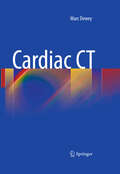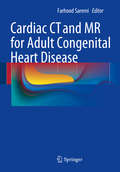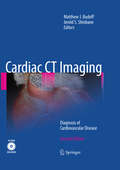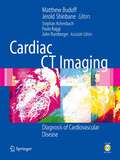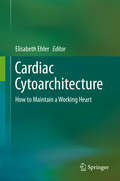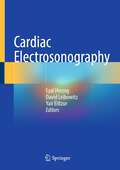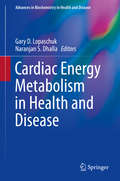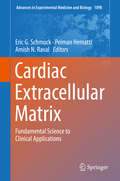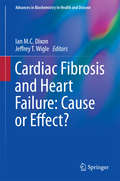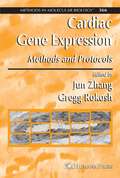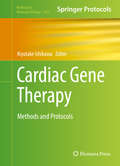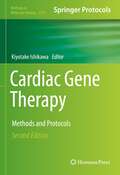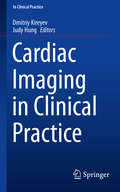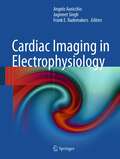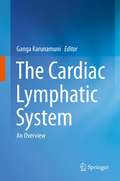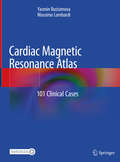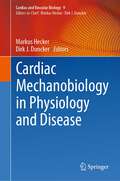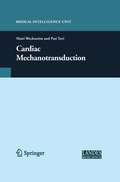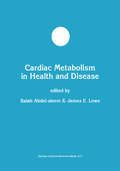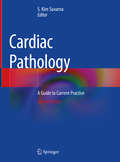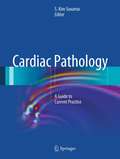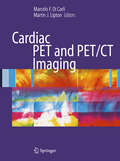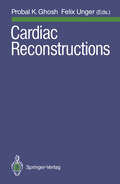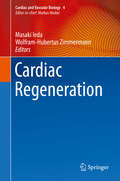- Table View
- List View
Cardiac CT
by Marc DeweyComputed tomography of the heart has become a highly accurate diagnostic modality that is attracting increasing attention. This extensively illustrated book aims to assist the reader in integrating cardiac CT into daily clinical practice, while also reviewing its current technical status and applications. Clear guidance is provided on the performance and interpretation of imaging using the latest technology, which offers greater coverage, better spatial resolution, and faster imaging. The specific features of scanners from all four main vendors, including those that have only recently become available, are presented. Among the wide range of applications and issues to be discussed are coronary artery bypass grafts, stents, plaques, and anomalies, cardiac valves, congenital and acquired heart disease, and radiation exposure. Upcoming clinical uses of cardiac CT, such as plaque imaging and functional assessment, are also explored.
Cardiac CT and MR for Adult Congenital Heart Disease
by Farhood SaremiThis is the first major textbook to address both computed tomography (CT) and magnetic resonance (MR) cardiac imaging of adults for the diagnosis and treatment of congenital heart disease (CHD). Since the introduction of faster CT scanners, there has been tremendous advancement in the diagnosis of CHD in adults. This is mostly due to the higher spatial resolution of CT compared to MR, which enables radiologists to create more detailed visualizations of cardiac anatomic structures, leading to the discovery of anomalous pathologies often missed by conventional MR imaging. This book is unique in highlighting the advantages of both CT and MR for the diagnosis of CHD in adults, focusing on the complementary collaboration between the two modalities that is possible. Chapters include discussions of case examples, clinical data, MR and CT image findings, and correlative cadaveric pictures. The chapters focus not only on the diagnosis of the primary problem, but also give readers information on visual clues to look for that often reveal associated pathologies. This book appeals primarily to diagnostic and interventional radiologists, as well as cardiologists and interventional cardiologists.
Cardiac CT Imaging: Diagnosis of Cardiovascular Disease
by Matthew J. Budoff Jerold S. ShinbaneCT is an accurate technique for assessing cardiac structure and function, but advances in computing power and scanning technology have resulted in increased popularity. It is useful in evaluating the myocardium, coronary arteries, pulmonary veins, thoracic aorta, pericardium, and cardiac masses; because of this and the speed at which scans can be performed, CT is even more attractive as a cost-effective and integral part of patient evaluation. This book collates all the current knowledge of cardiac CT and presents it in a clinically relevant and practical format appropriate for both cardiologists and radiologists. The images have been supplied by an experienced set of contributing authors and represent the full spectrum of cardiac CT. As increasing numbers have access to cardiac CT scanners, this book provides all the relevant information on this modality. This is an extensive update of the previous edition bringing the reader up-to-date with the immense amount of updated content in the discipline.
Cardiac CT Imaging: Diagnosis of Cardiovascular Disease
by Matthew J. Budoff Jerold S. ShinbaneCT is an accurate technique for assessing cardiac structure and function, but advances in computing power and scanning technology have resulted in increased popularity. It is useful in evaluating the myocardium, coronary arteries, pulmonary veins, thoracic aorta, pericardium, and cardiac masses; because of this and the speed at which scans can be performed, CT is even more attractive as a cost-effective and integral part of patient evaluation. This book collates all the current knowledge of cardiac CT and presents it in a clinically relevant and practical format appropriate for both cardiologists and radiologists. The images have been supplied by an experienced set of contributing authors and represent the full spectrum of cardiac CT. As increasing numbers have access to cardiac CT scanners, this book provides all the relevant information on this modality.
Cardiac cycle
by RnibThis diagram shows a detailed diagram of the heart during the cardiac cycle. There is a key on page 1 showing labels and different texture representing blood. There are arrows on the diagram to show the direction of blood flow.
Cardiac Cytoarchitecture: How to Maintain a Working Heart
by Elisabeth EhlerThis book presents a collection of expert reviews on different subcellular compartments of the cardiomyocyte, addressing fundamental questions such as how these compartments are assembled during development, how they are changed in and by disease and which signaling pathways have been implicated in these processes so far. As such, it offers the first overview of the cell biology of heart disease of its kind, addressing the needs of cell biology students specializing in vascular and cardiac biology, as well as those of cardiologists and researchers in the field of cell biology.
Cardiac Electrosonography
by Eyal Herzog David Leibowitz Yair ElitzurThis book focuses on a new clinical algorithmic approach to acute patient care based on the combination of electrocardiography (ECG) and echocardiography performance and interpretation, now renamed: ECG-sonography or electrosonography. The combination of these two basic skills improves patient management by healthcare providers in the acute setting. ECG is one of the oldest diagnostic tools in evaluating patients with cardiovascular symptoms and multiple and complex criteria for its interpretation have been developed over the past decades. The use of point of care ultrasound based on handheld echocardiography has recently emerged as an important clinical tool, particularly in the emergency department (ED) and intensive care unit. These studies are mainly performed by non-cardiologists including intensivists and ED physicians in addition to the physical exam and standard diagnostic tests such as the chest X-ray and laboratory tests to evaluate patients quickly and efficiently.Cardiac Electrosonography provides a new algorithmic approach to ECG interpretation and a simple tutorial of echocardiography performance and interpretation with a major focus on handheld echocardiography. It includes representative cases of patients presenting to the ED with a specific, acute cardiovascular symptom and demonstrates appropriate use of both ECG and echocardiography to improve patient management and outcome. It therefore represents an essential guide to this hybrid procedure for all practicing and trainee cardiologists and all healthcare professionals who manage these patients.
Cardiac Energy Metabolism in Health and Disease (Advances in Biochemistry in Health and Disease #11)
by Gary D. Lopaschuk Naranjan S. DhallaThe heart has a very high energy demand but very little energy reserves. In order to sustain contractile function, the heart has to continually produce a large amount of ATP. The heart utilizes free fatty acids mainly and carbohydrates to some extent as substrates for making energy and any change in this energy supply can seriously compromise cardiac function. It has emerged that alterations in cardiac energy metabolism are a major contributor to the development of a number of different forms of heart disease. It is also now known that optimizing energy metabolism in the heart is a viable and important approach to treating various forms of heart disease.Cardiac Energy Metabolism in Health and Disease describes the research advances that have been made in understanding what controls cardiac energy metabolism at molecular, transcriptional and physiological levels. It also describes how alterations in energy metabolism contribute to the development of heart dysfunction and how optimization of energy metabolism can be used to treat heart disease. The topics covered include a discussion of the effects of myocardial ischemia, diabetes, obesity, hypertrophy, heart failure, and genetic disorders of mitochondrial oxidative metabolism on cardiac energetics. The treatment of heart disease by optimizing energy metabolism is also discussed, which includes increasing overall energy production as well as increasing the efficiency of energy production and switching energy substrate preference of the heart. This book will be a valuable source of information to graduate students, postdoctoral fellows, and investigators in the field of experimental cardiology as well as biochemists, physiologists, pharmacologists, cardiologists, cardiovascular surgeons and other health professionals.
Cardiac Extracellular Matrix: Fundamental Science to Clinical Applications (Advances in Experimental Medicine and Biology #1098)
by Eric G. Schmuck Peiman Hematti Amish N. RavalThis book on cardiac extracellular matrix (ECM) features three sections, Fundamental Science, Pre-Clinical and Translational Science, and Clinical Applications. In the Fundamental Science section, we will cover the spectrum of basic ECM science from ECM’s role in development, biomechanical properties, cardiac ECM influence of cardiomyocyte biology, pathophysiology of ECM in heart disease, and ECM in tissue engineering. Section two, Preclinical and Translational Science, will discuss cardiac ECM technologies in the clinical pipeline including approaches to ECM as a therapeutic, animal models of cardiac research, tracking and imaging methods of cardiac ECM, and cGMP manufacturing and regulatory considerations for ECM based therapeutics. Finally, the third section, Clinical Applications, will highlight the clinical experience around cardiac ECM including therapeutic strategies targeting scar tissue in the heart, Clinical trial design and regulatory considerations, current human clinical trials in cardiovascular medicine and the role of pharmaceutical and biotech companies in the commercialization of ECM technologies for cardiovascular indications. This book provides a comprehensive review for basic and translational researchers as well as clinical practitioners and those involved in commercialization, regulatory and entrepreneurial activities.
Cardiac Fibrosis and Heart Failure: Cause Or Effect? (Advances in Biochemistry in Health and Disease #13)
by Ian M.C. Dixon Jeffrey T. WigleThe unique biology of cardiac fibroblasts and related cells, such as cardiac myofibroblasts and valvular interstitial cells, distinguish them from other fibroblastic cells, a concept that is only beginning to be widely appreciated. Further, the natural signals that stimulate and inhibit cardiac fibrosis within these cells are not well understood. This volume compiles articles that address the molecular mechanisms that control the synthesis and secretion of the cardiac ECM. The book showcases chapters that highlight discussion of role of Transforming Growth Factor β (TGFβ), an important fibrogenic cytokine and its downstream effectors SMAD in many cardiac diseases. Further, the contributions highlight information to discuss endogenous inhibitors of cardiac fibrosis, as well as advances in tissue engineering specific to matrix in the heart. Finally, discussions of unifying mechanisms of matrix remodeling in valves and myocardium are presented.The mechanisms involved in the stimulation of cardiac fibrosis are not fully understood. In most cases the marginal attenuation of cardiac fibrosis as a result of a given therapy is a beneficial side-effect linked to other primary effects on other cells, especially cardiomyocytes. Very few drugs or agents are known to affect the function and dysfunction of cardiac fibroblasts and myofibroblasts alone. The book helps to translate the information gathered within to allow us to alter the course of fibrogenic events that are typical of cardiac fibrosis, and thereby reduce their burden on the patient and on society itself.
Cardiac Gene Expression: Methods and Protocols (Methods in Molecular Biology #366)
by Jun Zhang and Gregg RokoshThis book presents both cutting-edge and established methods for studying cardiac gene expression. The protocols provide a template for solid research, and cover the process through screening, analysis, characterization, and functional confirmation of novel genes or known genes with a new function. The concluding section of the book highlights methods that facilitate overexpression or cardiac-specific targeted gene deletion.
Cardiac Gene Therapy: Methods and Protocols (Methods in Molecular Biology #1521)
by Kiyotake IshikawaThis detailed book provides methodological information on cardiac gene delivery, from classic to state-of-the-art technologies and techniques. Efficient, cardiac-specific, and safe vectors, as well as refined vector delivery methods, are key for successful cardiac gene transfer and eventually for improving patients’ outcomes. Newer vectors and more efficient vector delivery methods have the potential to dramatically improve gene transduction efficacy, while novel gene manipulation techniques enforce the therapeutic power and broaden disease targets. Written for the highly successful Methods in Molecular Biology series, chapters include introductions to their respective topics, lists of the necessary materials and reagents, step-by-step, readily reproducible laboratory protocols, and tips on troubleshooting and avoiding known pitfalls. Authoritative and practical, Cardiac Gene Therapy: Methods and Protocols serves as a valuable tool for molecular biologists and physiologists in the cardiology field conducting cardiac gene transfer research, which will ultimately lead to further advancements in the vital field.
Cardiac Gene Therapy: Methods and Protocols (Methods in Molecular Biology #2573)
by Kiyotake IshikawaThis second edition volume expands on the previous edition with updated techniques and discussions on topics such as gene suppression, editing, and reprogramming; cardiac gene therapy vectors and promoters; cardiac gene delivery methods; pulmonary hypertension; and patient screening and measuring the efficacy of cardiac gene therapy. Written in the highly successful Methods in Molecular Biology series format, chapters include introductions to their respective topics, lists of the necessary materials and reagents, step-by-step, readily reproducible laboratory protocols, and tips on troubleshooting and avoiding known pitfalls. Cutting-edge and comprehensive, Cardiac Gene Therapy: Methods and Protocols, Second Edition is a valuable tool for researchers in cardiology who are conducting gene therapy research. This book will lead to further advancements and successful clinical translations in the field.
Cardiac Imaging in Clinical Practice (In Clinical Practice)
by Dmitriy Kireyev Judy HungThis book provides a concise guide to echocardiography, SPECT, CT and MRI, including both the basics of cardiac imaging as well as tables of normal/abnormal values and guidelines.With advances in technology, cardiac CT and MRI are becoming more popular but are often limited to larger medical centers. By including the basics of these modalities, this book provides a comprehensive guide for a wide range of medical professionals. As physicians outside of cardiology often do not have sufficient exposure to nuclear stress tests, this book contains SPECT and stress test protocols in order to facilitate decision-making when ordering tests and interpreting results.Cardiac Imaging in Clinical Practice is a quick reference guide and will be useful at multiple levels of training, enabling the book to be used as a basic and advanced reference source. As such, it is appropriate for students, residents, fellows and staff attendings who want a practical and handy reference to the diagnostic options open to them.
Cardiac Imaging in Electrophysiology
by Angelo Auricchio, Jagmeet Singh and Frank E. RademakersCardiac arrhythmias are a major cause of death (7 million cases annually worldwide; 400,000 in the U.S. alone) and disability. Yet, a noninvasive imaging modality to identify patients at risk, provide accurate diagnosis and guide therapy is not yet available in clinical practice. Nevertheless, there are various applications of electrophysiologic imaging in humans from ECG/CT reconstructions, MRI to tissue Doppler investigations that provide supplimentary diagnostic data to the cardiologist. EP laboratories are experiencing an increase in volume, for both diagnostic and interventional electrophysiology studies, including mapping, ablation, and pacemaker implants. The equipment requirements for these procedures are stringent, include positioning capabilities, and dose management. This book is designed to review all of the current imaging methodologies that assist in diagnosis within the electrophysiology department.
The Cardiac Lymphatic System: An Overview
by Ganga KarunamuniThe heart is invested with a complex, intertwining network of blood and lymphatic vessels which, respectively, provide the cardiac tissue with oxygen and nutrients and eliminate excess fluid from the interstitium. The coronary blood vessels have been the focus of much investigation in the past few decades. On the other hand, the literature regarding the cardiac lymphatic vessels remains sparse, despite their important role in maintaining normal heart function. With this in mind, a better understanding of the cardiac lymphatic network and its ability to regulate fluid homeostasis within the heart could give us insight into developing therapies for the alleviation of several cardiac pathological conditions.
Cardiac Magnetic Resonance Atlas: 101 Clinical Cases
by Yasmin Rustamova Massimo LombardiThis book presents the main cardiac pathologies, providing a helpful guide featuring clinical cases and electronic supplementary material. There are several systematic books on cardiac magnetic resonance, which approach the different pathologies and related pathophysiology in a general manner, and these are useful for readers at an early stage in their medical careers. However, when it comes to individual patients (during the acquisition of images and reporting activities) there is no book providing operative protocols or systematic descriptions of details to look for. In the eight chapters (Cardiomyopathies, Myocarditis, Ischemic Heart Disease, Valvular Heart Diseases, Cardiac Masses, Pericardial Diseases, Congenital Heart Disease, and Miscellanea), the individual pathology is illustrated with a clinical case.The cases are divided into four sections: An introduction with a short medical history and the purpose of the diagnostic CMRA detailed CMR acquisition protocolCMR images, indicating purpose, method, analysis and meaning of the image, as well as videos.Concluding paragraph with the final diagnosis reached on the basis of the findings obtained in each image This book, collecting one hundred one clinical cases covering a broad spectrum of cardiac diseases, is an invaluable tool for radiologists and cardiologists.
Cardiac Mechanobiology in Physiology and Disease (Cardiac and Vascular Biology #9)
by Markus Hecker Dirk J. DunckerThis book presents the latest findings in the field of cardiac mechanobiology in health and disease.Cardiac mechanobiology provides knowledge of all aspects of mechanobiology of the heart. Cardiomyogenesis is discussed as well as the mechanobiology of cardiac remodeling and regeneration. The molecular mechanisms of mechanoperception and mechanotransduction in cardiomyocytes are explained, as well as stretch induced differentiation of cardiomyocytes derived from induced pluripotent stem cells. This volume of the series Cardiac and Vascular Biology complements the volume Vascular Mechanobiology in Physiology and Disease (volume 8) published in this series. The book is aimed at clinicians as well as researchers in cardiovascular biology, bioengineering and biophysics, and also represents an educational resource for young researchers and students in these fields.
Cardiac Mechanotransduction
by Matti Weckström Pasi TaviThis book presents a multidisciplinary approach to cardiac mechanotransduction. The chapters depict the many faces of the topic, from membrane and ion channel level to mechanics, biochemical signaling and regulation via hormone systems. Cardiac Mechanotransduction is of interest to basic life sciences, like physiology, biochemistry and pharmacology, but also to clinicians working with heart-related problems, such as cardiologists and internists.
Cardiac Metabolism in Health and Disease (Developments in Molecular and Cellular Biochemistry #23)
by James E. Lowe SalahAbdel-AleemThis special issue of Molecular and Cellular Biochemistry contains original research papers as well as invited reviews focused in the field of cardiac metabolism and its regulation under normal and disease conditions. These papers cover many areas under intensive and rapid development such as the regulation of fatty acid oxidation in the heart, the role of cardiac glycogen during ischemia, the role of CPT I isoenzymes, the pathophysiology of diabetic cardiomyopathy, cardiac protection through regulation of energy production, the role of fatty acid binding protein under normal and pathological conditions, and several other important topics in this area of research. We hope that this special issue of Molecular and Cellular Biochemistry provides an up-to-date source of information for scientists and clinicians interested in the mechanism by which cardiac metabolism is regulated in health and disease and the mechanistic relationship between disturbances in cardiac metabolism and the genesis of cardiovascular diseases.
Cardiac Pathology: A Guide to Current Practice
by S. Kim SuvarnaThis updated second edition provides a comprehensive overview of cardiac pathology. Clear illustrations of the common styles of dissection are provided along with the normal anatomy and histology. The chapters cover autopsy heart examination, ischemic heart disease, myocarditis, sudden death, valvular disease, transplant pathology, cardiomyopathy, cardiac neoplasia and congenital heart disease with a clear analysis of diagnostic criteria (macroscopic, microscopic and genetic) for both common cardiac diseases and those of less common types. The text is accompanied by high quality macroscopic and microscopic images and references to other specialty data sources. Cardiac Pathology: A Guide to Current Practice is aimed at established pathologists and trainees, as well as any clinician with an interest in cardiac disease. It will be of value to those working in cardiac surgery, cardiology and those in the autopsy/forensic fields.
Cardiac Pathology: A Guide to Current Practice
by S. Kim SuvarnaCardiac disorders are an exciting area of classic pathology and recently defined disease. Cardiac Pathology: A Guide to Current Practice discusses the various disorders and also provides a backdrop of developmental embryology, diagnostic imaging and current therapeutics. Cardiac Pathology: A Guide to Current Practice aims to deliver in bench-book format a comprehensive overview of cardiac pathology that is relevant to those practicing in surgical pathology and autopsy arenas. Clear illustrations of the common styles of dissection are provided along with the normal anatomy and histology. Chapters cover the approach to the autopsy heart, ischemic heart disease, myocarditis, sudden death, valvular disease, transplant pathology, cardiomyopathy, cardiac neoplasia and congenital heart disease with a clear analysis of diagnostic criteria (macroscopic, microscopic and genetic) for both common cardiac diseases and those of rare format. The text is accompanied by high-quality macroscopic and microscopic images and references to other in-depth specialty data sources. Although aimed in particular at pathologists, Cardiac Pathology: A Guide to Current Practice should also be of value to cardiologists, cardiothoracic surgeons and other professions allied to medicine.
Cardiac PET and PET/CT Imaging
by Marcello F. Di Carli Martin J. LiptonThis book presents the most up-to-date information on the practice of cardiac PET and hybrid PET/CT. Each chapter takes a step-by-step approach, from basic principles of instrumentation, imaging, and protocols to advanced discussions of current and future clinical applications. Coverage also includes a perspective on other emerging imaging modalities, such as MRI, and the relative role of each. In addition, the volume details the technical aspects of cardiac PET and PET/CT imaging. A library of original cases completes the text by illustrating interpretation and technical challenges in cardiac PET and hybrid PET/CT.
Cardiac Reconstructions
by Probal K. Ghosh Felix UngerAttempts to reconstruct various parts of the heart started even before the beginning of open cardiac surgery. By the late 1950s and early 1960 s several closed and open procedures had already been described. In that era, several surgeons in Europe and the Americas were particularly prompted to develop various techniques of valve re construction because of the lack of acceptable valve prostheses and conduits which have become available subsequently. At that time, several congenital lesions still defied definitive correction, and clinical attempts at left ventricular wall replacement had not yet got under way. A renaissance in different cardiac reconstructive procedures started at the beginning of the 1980s. As the problems relating to valve prostheses became more generally appreciated and the importance of chamber volumes and geometry (atrial or ventricular) was accorded due importance in the long-term follow-up, there was a resurgence of surgical attempts at reconstruction in congenital and acquired cardiac lesions so as to approximate the natural state. At the same time several characteristics of this reconstructive "discipline" became apparent. First, cardiac reconstructive surgery has remained a surgical "art" with a gradually increasing number of interested cardiac surgeons.
Cardiac Regeneration (Cardiac and Vascular Biology)
by Masaki Ieda Wolfram-Hubertus ZimmermannThis Volume of the series Cardiac and Vascular Biology offers a comprehensive and exciting, state-of-the-art work on the current options and potentials of cardiac regeneration and repair.Several techniques and approaches have been developed for heart failure repair: direct injection of cells, programming of scar tissue into functional myocardium, and tissue-engineered heart muscle support. The book introduces the rationale for these different approaches in cell-based heart regeneration and discusses the most important considerations for clinical translation. Expert authors discuss when, why, and how heart muscle can be salvaged.The book represents a valuable resource for stem cell researchers, cardiologists, bioengineers, and biomedical scientists studying cardiac function and regeneration.
